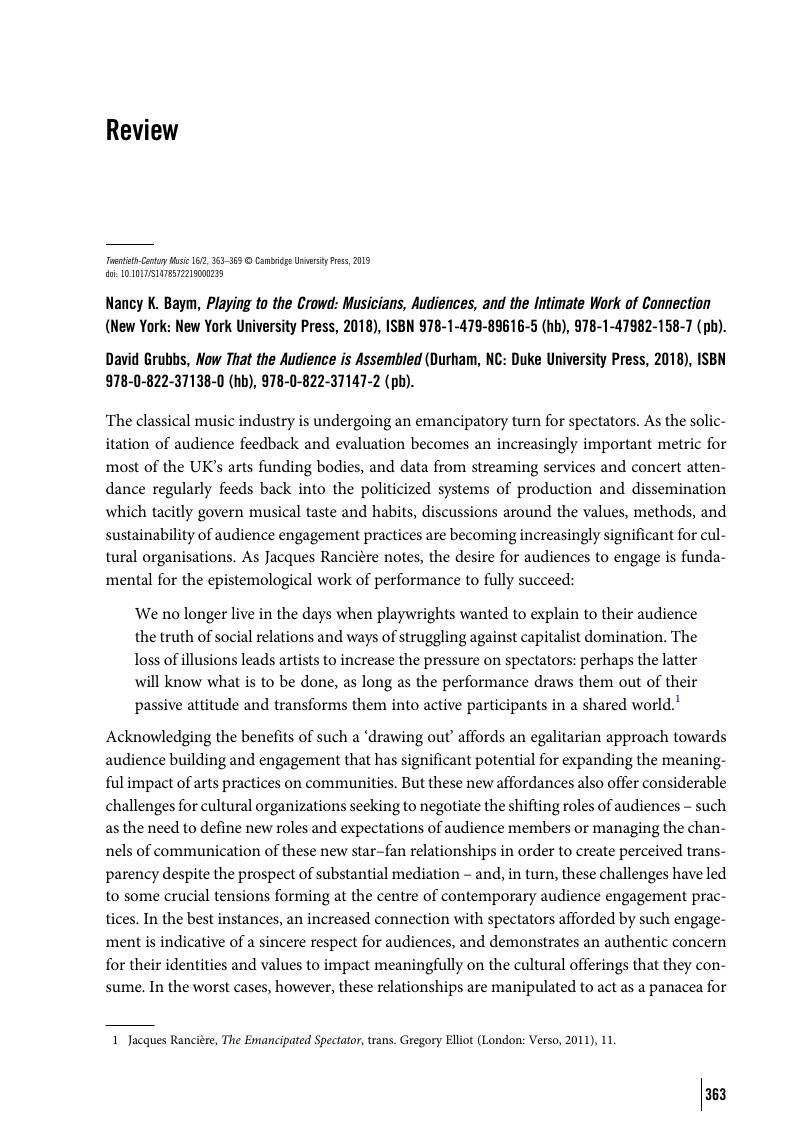No CrossRef data available.
Article contents
Nancy K. Baym, Playing to the Crowd: Musicians, Audiences, and the Intimate Work of Connection (New York: New York University Press, 2018), ISBN 978-1-479-89616-5 (hb), 978-1-47982-158-7 (pb). - David Grubbs, Now That the Audience is Assembled (Durham, NC: Duke University Press, 2018), ISBN 978-0-822-37138-0 (hb), 978-0-822-37147-2 (pb).
Published online by Cambridge University Press: 30 April 2019
Abstract

- Type
- Reviews
- Information
- Copyright
- Copyright © Cambridge University Press, 2019
References
1 Rancière, Jacques, The Emancipated Spectator, trans. Elliot, Gregory (London: Verso, 2011), 11Google Scholar.
2 On audience engagement and community building, see Bishop, Claire, Participation (Cambridge: Whitechapel, 2016)Google Scholar; Gauntlett, David, Making is Connecting: The Social Meaning of Creativity, from DIY and Knitting to YouTube and Web 2.0 (Cambridge: Polity Press, 2011)Google Scholar; Matarasso, François, ‘Creative Progression: Reflections on Quality in Participatory Arts’, UNESCO Observatory Multi-Disciplinary Journal in the Arts 3/3 (2013), 1–15Google Scholar.
3 Zelizer, Viviana, The Purchase of Intimacy (Princeton: Princeton University Press, 2005)Google Scholar.
4 For discussions of emotional labour and music, see Pettinger, Lynne, ‘Embodied Labour in Music Work’, The British Journal of Sociology 66/2 (2015), 282–300CrossRefGoogle ScholarPubMed; Watson, Allan and Ward, Jenna, Right, ‘Creating the “Vibe”: Emotional Labour and Musical Performance in the Recording Studio’, Economy and Space 45/12 (2013), 2904–18CrossRefGoogle Scholar.
5 This issue is interrogated in book, Baym's earlier, Personal Connections in the Digital Age (New York: Polity, 2010)Google Scholar.
6 Cf. Klein, Bethany et al. ‘Selling Out: Musicians, Autonomy, and Compromise in the Digital Age’, Popular Music and Society 40/2 (2016), 222–38CrossRefGoogle Scholar.
7 Another thread lacking from Baym's account is the embodied labour required for these tasks, where the body is a site of both artistic practice and communication. See De Jaegher, Hanne et al. ‘Can Social Interaction Constitute Social Cognition?’, Trends in Cognitive Sciences 14/10 (2010), 441–7CrossRefGoogle ScholarPubMed.
8 Hochschild, Arlie Russell, The Managed Heart: Commercialization of Human Feeling (Berkeley: University of California Press, 1983)Google Scholar.
9 ‘Academic consideration of authenticity should … shift from consideration of the intention of various originators towards the activities of various perceivers, and should focus on the reasons they might have for finding, or failing to find, a particular performance authentic’ (Moore, Allan, ‘Authenticity as Authentication’, Popular Music 21/2 (2002), 221CrossRefGoogle Scholar).
10 Baym elsewhere comments that: ‘Music has always been about building, sustaining, and reworking social relationships and institutions … [and] no matter how commercialized it becomes, it can never be just a product’ (69).
11 Baudrillard, Jean, ‘Transpolitics, Transsexuality, Transaesthetics’, Jean Baudrillard: The Disapperance of Art and Politics, ed. Stearns, William and Chaloupka, William (New York: St Martin's Press, 1992), 10Google Scholar.
12 The book presents commentaries on a number of interviews with a broad range of successful and mainstream mid-career artists, including R.E.M., Amanda Palmer, Richie Hawtin, Zoë Keating, and Billy Bragg, who are described as sharing a desire for successful communication with fans in order to ‘give and gain social meaning … [whilst] seeking to make money in contexts dominated by capitalist market logics’ (28). An accompanying Spotify playlist of their music offers a wonderfully ironic commentary.
13 Born, Georgina, ‘Mediating the Public Sphere: Digitisation, Pluralism, and Communicative Democracy’, in Beyond Habermas: Democracy, Knowledge, and the Public Sphere, ed. Emden, Christian J. and Midgley, David (London and New York: Berghahn, 2012), 126Google Scholar.
14 ‘It might be considered a kind of imaginative doing, as audiences suspend disbelief; or an emotional doing, as spectators invest sympathy with the characters or performance. The audience experience might also be considered an intersubjective doing, through kinaesthetic empathy with the movement and presence of people in space’ (Reason, Matthew, The Young Audience: Exploring and Enhancing Children's Experiences of Theatre (Stoke: Trentham Books/IOE Press, 2010), 19Google Scholar).


